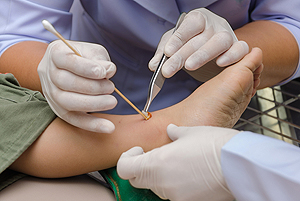 People with diabetes may be familiar with diabetic foot ulcers (DFUs), which are poorly healing wounds that can develop on the feet. When it comes to caring for DFUs, there are several key steps. The first step is to remove the cause of the wound. Often, the cause is pressure or friction, and removing it requires taking off any constricting footwear and resting the affected foot. Your doctor may prescribe you an orthotic device or special shoes to keep pressure off the wound. It is also important to keep the wound environment moist, remove any dead tissue, take measures to reduce chances of infection, and make sure that there is adequate blood flow to the feet. These are all things that your podiatrist can do. To learn more about caring for DFUs, please consult with a podiatrist.
People with diabetes may be familiar with diabetic foot ulcers (DFUs), which are poorly healing wounds that can develop on the feet. When it comes to caring for DFUs, there are several key steps. The first step is to remove the cause of the wound. Often, the cause is pressure or friction, and removing it requires taking off any constricting footwear and resting the affected foot. Your doctor may prescribe you an orthotic device or special shoes to keep pressure off the wound. It is also important to keep the wound environment moist, remove any dead tissue, take measures to reduce chances of infection, and make sure that there is adequate blood flow to the feet. These are all things that your podiatrist can do. To learn more about caring for DFUs, please consult with a podiatrist.
Wound care is an important part in dealing with diabetes. If you have diabetes and a foot wound or would like more information about wound care for diabetics, consult with Emil Lavian,DPM from Maven Podiatry. Our doctor will assess your condition and provide you with quality foot and ankle treatment.
What Is Wound Care?
Wound care is the practice of taking proper care of a wound. This can range from the smallest to the largest of wounds. While everyone can benefit from proper wound care, it is much more important for diabetics. Diabetics often suffer from poor blood circulation which causes wounds to heal much slower than they would in a non-diabetic.
What Is the Importance of Wound Care?
While it may not seem apparent with small ulcers on the foot, for diabetics, any size ulcer can become infected. Diabetics often also suffer from neuropathy, or nerve loss. This means they might not even feel when they have an ulcer on their foot. If the wound becomes severely infected, amputation may be necessary. Therefore, it is of the upmost importance to properly care for any and all foot wounds.
How to Care for Wounds
The best way to care for foot wounds is to prevent them. For diabetics, this means daily inspections of the feet for any signs of abnormalities or ulcers. It is also recommended to see a podiatrist several times a year for a foot inspection. If you do have an ulcer, run the wound under water to clear dirt from the wound; then apply antibiotic ointment to the wound and cover with a bandage. Bandages should be changed daily and keeping pressure off the wound is smart. It is advised to see a podiatrist, who can keep an eye on it.
If you have any questions, please feel free to contact our office located in New York, NY . We offer the newest diagnostic and treatment technologies for all your foot care needs.
Read more about Wound Care
